Business Intelligence, Data Warehousing, and Data Mining Report
VerifiedAdded on 2023/01/12
|7
|1700
|69
Report
AI Summary
This report provides a comprehensive overview of Business Intelligence (BI), data warehousing, and data mining, focusing on their current trends and applications. It begins by defining BI as a set of techniques and systems for transforming raw data into valuable information to enhance business performance, using Panintelligence Limited as a case study. The report then explores the key components of BI, including business reporting, which is essential for providing insights to stakeholders and improving decision-making. Data warehousing is examined as a mechanism for gathering and storing data from diverse sources, enabling ad hoc inquiries and predictive analysis. Data mining is presented as a process that transforms raw data into useful information, identifying trends and patterns. The report also delves into predictive analytics, highlighting its use of statistical techniques and machine learning to forecast future outcomes. It examines applications such as fraud detection, marketing campaign optimization, operations improvement, and risk reduction. The conclusion emphasizes the significant impact of BI and data handling on corporate financial, organizational, and strategic decisions.
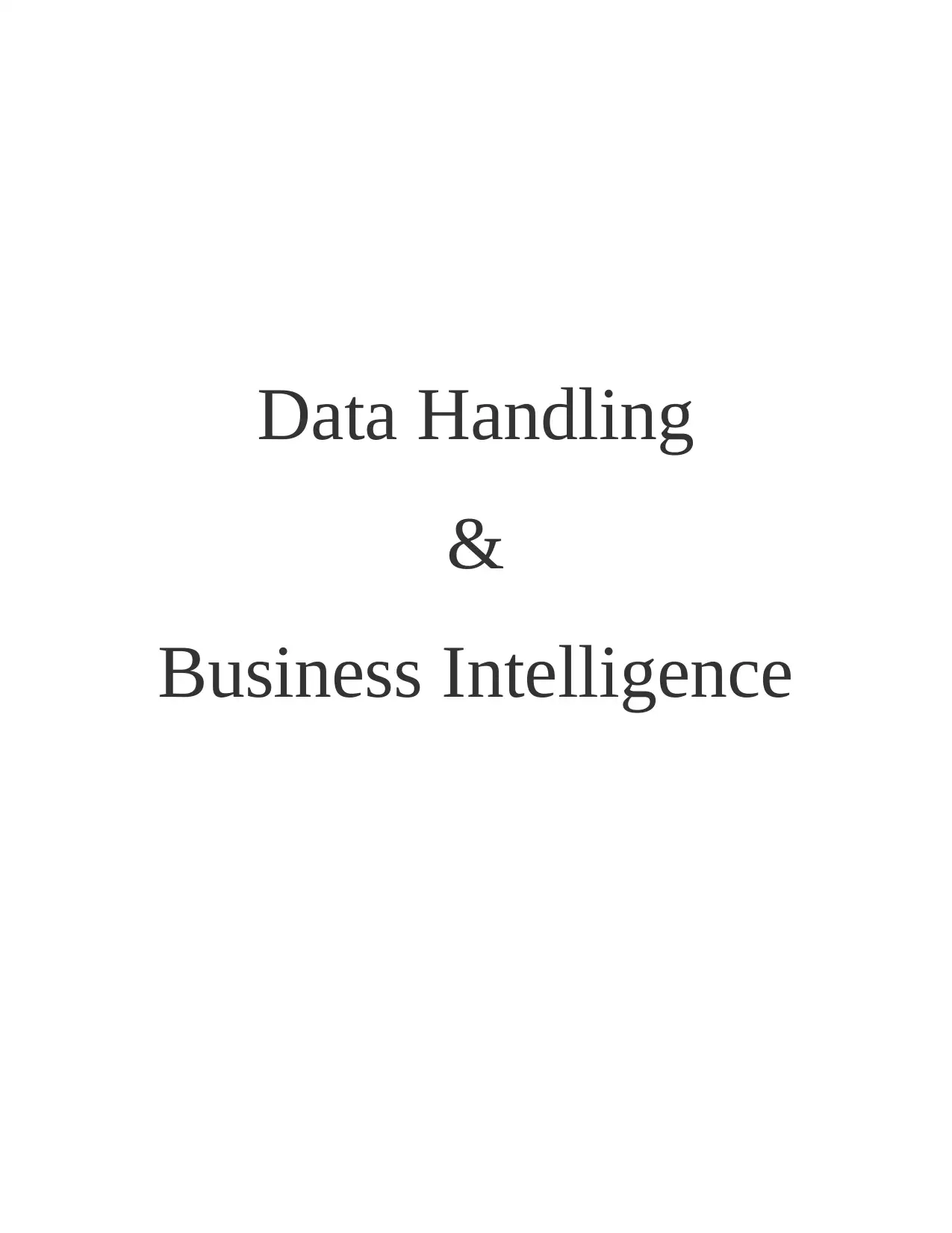
Data Handling
&
Business Intelligence
&
Business Intelligence
Paraphrase This Document
Need a fresh take? Get an instant paraphrase of this document with our AI Paraphraser

Table of Contents
INTRODUCTION...........................................................................................................................1
TASK...............................................................................................................................................1
1. Identification and critically evaluation of current trends in data warehousing, business
intelligence and data mining:.......................................................................................................1
Business Intelligence...................................................................................................................1
Data warehousing........................................................................................................................2
Data mining.................................................................................................................................2
2. Demonstration of thorough knowledge of basic concepts and principles using predictive
analytics software:.......................................................................................................................3
CONCLUSION................................................................................................................................4
REFERENCES................................................................................................................................5
INTRODUCTION...........................................................................................................................1
TASK...............................................................................................................................................1
1. Identification and critically evaluation of current trends in data warehousing, business
intelligence and data mining:.......................................................................................................1
Business Intelligence...................................................................................................................1
Data warehousing........................................................................................................................2
Data mining.................................................................................................................................2
2. Demonstration of thorough knowledge of basic concepts and principles using predictive
analytics software:.......................................................................................................................3
CONCLUSION................................................................................................................................4
REFERENCES................................................................................................................................5
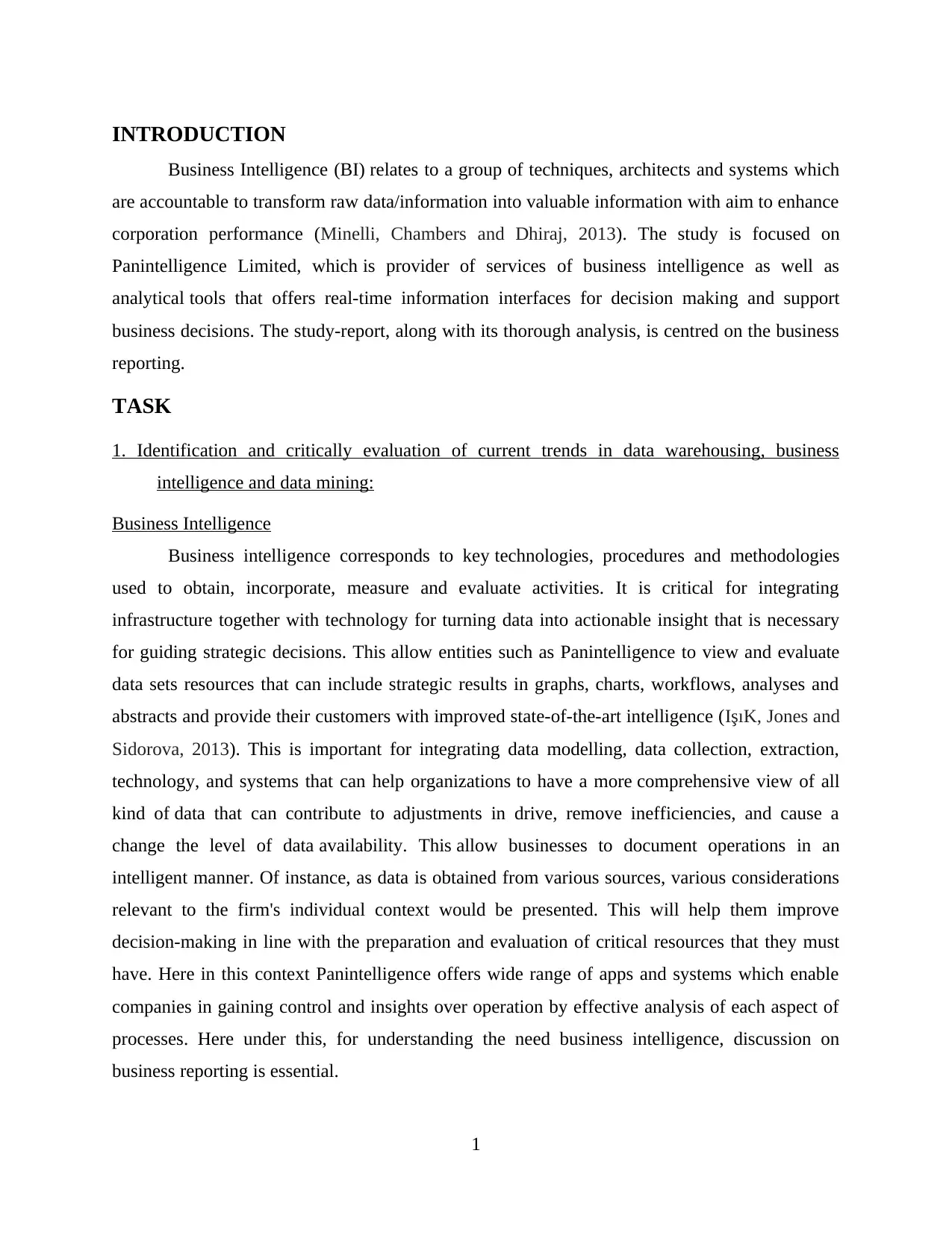
INTRODUCTION
Business Intelligence (BI) relates to a group of techniques, architects and systems which
are accountable to transform raw data/information into valuable information with aim to enhance
corporation performance (Minelli, Chambers and Dhiraj, 2013). The study is focused on
Panintelligence Limited, which is provider of services of business intelligence as well as
analytical tools that offers real-time information interfaces for decision making and support
business decisions. The study-report, along with its thorough analysis, is centred on the business
reporting.
TASK
1. Identification and critically evaluation of current trends in data warehousing, business
intelligence and data mining:
Business Intelligence
Business intelligence corresponds to key technologies, procedures and methodologies
used to obtain, incorporate, measure and evaluate activities. It is critical for integrating
infrastructure together with technology for turning data into actionable insight that is necessary
for guiding strategic decisions. This allow entities such as Panintelligence to view and evaluate
data sets resources that can include strategic results in graphs, charts, workflows, analyses and
abstracts and provide their customers with improved state-of-the-art intelligence (IşıK, Jones and
Sidorova, 2013). This is important for integrating data modelling, data collection, extraction,
technology, and systems that can help organizations to have a more comprehensive view of all
kind of data that can contribute to adjustments in drive, remove inefficiencies, and cause a
change the level of data availability. This allow businesses to document operations in an
intelligent manner. Of instance, as data is obtained from various sources, various considerations
relevant to the firm's individual context would be presented. This will help them improve
decision-making in line with the preparation and evaluation of critical resources that they must
have. Here in this context Panintelligence offers wide range of apps and systems which enable
companies in gaining control and insights over operation by effective analysis of each aspect of
processes. Here under this, for understanding the need business intelligence, discussion on
business reporting is essential.
1
Business Intelligence (BI) relates to a group of techniques, architects and systems which
are accountable to transform raw data/information into valuable information with aim to enhance
corporation performance (Minelli, Chambers and Dhiraj, 2013). The study is focused on
Panintelligence Limited, which is provider of services of business intelligence as well as
analytical tools that offers real-time information interfaces for decision making and support
business decisions. The study-report, along with its thorough analysis, is centred on the business
reporting.
TASK
1. Identification and critically evaluation of current trends in data warehousing, business
intelligence and data mining:
Business Intelligence
Business intelligence corresponds to key technologies, procedures and methodologies
used to obtain, incorporate, measure and evaluate activities. It is critical for integrating
infrastructure together with technology for turning data into actionable insight that is necessary
for guiding strategic decisions. This allow entities such as Panintelligence to view and evaluate
data sets resources that can include strategic results in graphs, charts, workflows, analyses and
abstracts and provide their customers with improved state-of-the-art intelligence (IşıK, Jones and
Sidorova, 2013). This is important for integrating data modelling, data collection, extraction,
technology, and systems that can help organizations to have a more comprehensive view of all
kind of data that can contribute to adjustments in drive, remove inefficiencies, and cause a
change the level of data availability. This allow businesses to document operations in an
intelligent manner. Of instance, as data is obtained from various sources, various considerations
relevant to the firm's individual context would be presented. This will help them improve
decision-making in line with the preparation and evaluation of critical resources that they must
have. Here in this context Panintelligence offers wide range of apps and systems which enable
companies in gaining control and insights over operation by effective analysis of each aspect of
processes. Here under this, for understanding the need business intelligence, discussion on
business reporting is essential.
1
⊘ This is a preview!⊘
Do you want full access?
Subscribe today to unlock all pages.

Trusted by 1+ million students worldwide
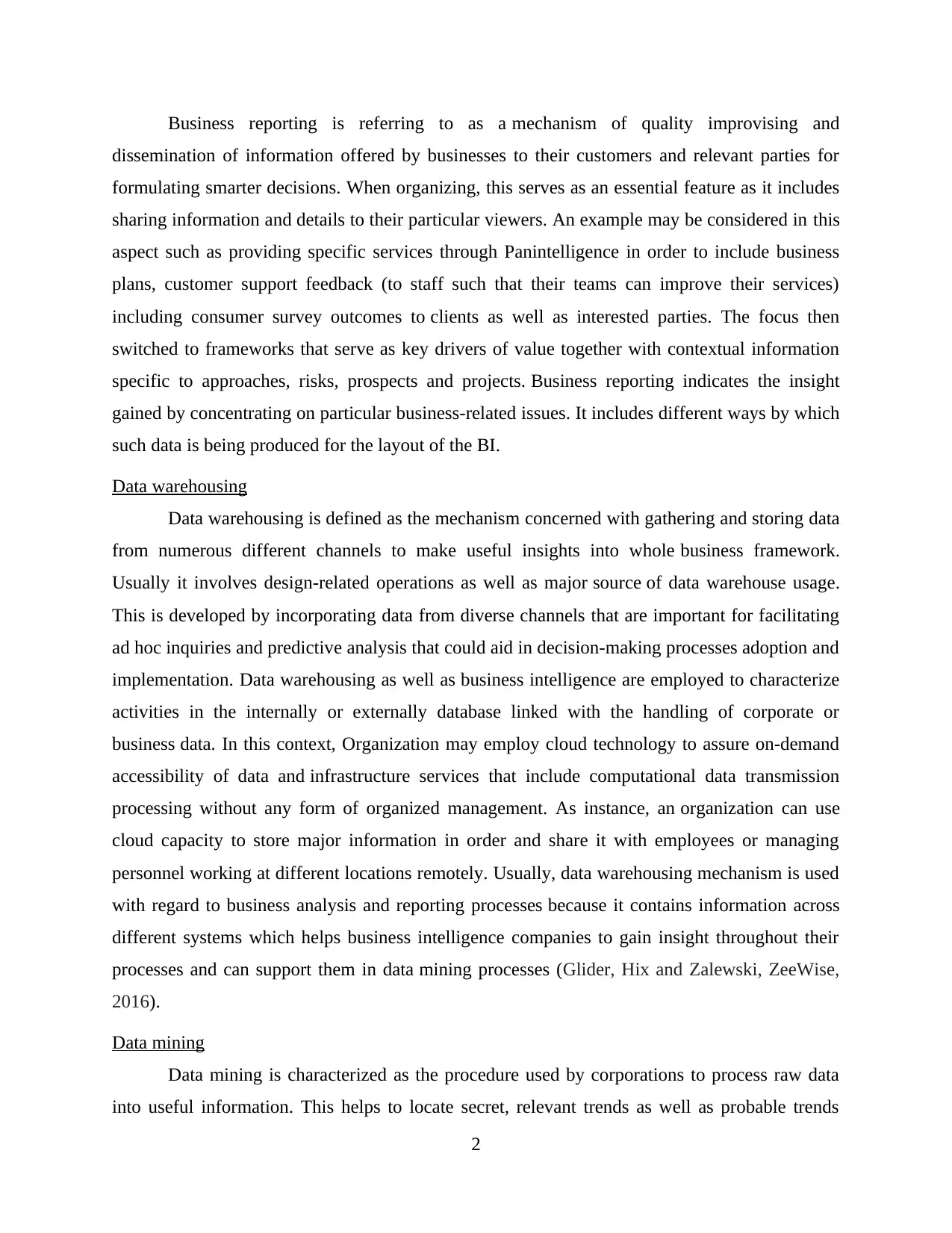
Business reporting is referring to as a mechanism of quality improvising and
dissemination of information offered by businesses to their customers and relevant parties for
formulating smarter decisions. When organizing, this serves as an essential feature as it includes
sharing information and details to their particular viewers. An example may be considered in this
aspect such as providing specific services through Panintelligence in order to include business
plans, customer support feedback (to staff such that their teams can improve their services)
including consumer survey outcomes to clients as well as interested parties. The focus then
switched to frameworks that serve as key drivers of value together with contextual information
specific to approaches, risks, prospects and projects. Business reporting indicates the insight
gained by concentrating on particular business-related issues. It includes different ways by which
such data is being produced for the layout of the BI.
Data warehousing
Data warehousing is defined as the mechanism concerned with gathering and storing data
from numerous different channels to make useful insights into whole business framework.
Usually it involves design-related operations as well as major source of data warehouse usage.
This is developed by incorporating data from diverse channels that are important for facilitating
ad hoc inquiries and predictive analysis that could aid in decision-making processes adoption and
implementation. Data warehousing as well as business intelligence are employed to characterize
activities in the internally or externally database linked with the handling of corporate or
business data. In this context, Organization may employ cloud technology to assure on-demand
accessibility of data and infrastructure services that include computational data transmission
processing without any form of organized management. As instance, an organization can use
cloud capacity to store major information in order and share it with employees or managing
personnel working at different locations remotely. Usually, data warehousing mechanism is used
with regard to business analysis and reporting processes because it contains information across
different systems which helps business intelligence companies to gain insight throughout their
processes and can support them in data mining processes (Glider, Hix and Zalewski, ZeeWise,
2016).
Data mining
Data mining is characterized as the procedure used by corporations to process raw data
into useful information. This helps to locate secret, relevant trends as well as probable trends
2
dissemination of information offered by businesses to their customers and relevant parties for
formulating smarter decisions. When organizing, this serves as an essential feature as it includes
sharing information and details to their particular viewers. An example may be considered in this
aspect such as providing specific services through Panintelligence in order to include business
plans, customer support feedback (to staff such that their teams can improve their services)
including consumer survey outcomes to clients as well as interested parties. The focus then
switched to frameworks that serve as key drivers of value together with contextual information
specific to approaches, risks, prospects and projects. Business reporting indicates the insight
gained by concentrating on particular business-related issues. It includes different ways by which
such data is being produced for the layout of the BI.
Data warehousing
Data warehousing is defined as the mechanism concerned with gathering and storing data
from numerous different channels to make useful insights into whole business framework.
Usually it involves design-related operations as well as major source of data warehouse usage.
This is developed by incorporating data from diverse channels that are important for facilitating
ad hoc inquiries and predictive analysis that could aid in decision-making processes adoption and
implementation. Data warehousing as well as business intelligence are employed to characterize
activities in the internally or externally database linked with the handling of corporate or
business data. In this context, Organization may employ cloud technology to assure on-demand
accessibility of data and infrastructure services that include computational data transmission
processing without any form of organized management. As instance, an organization can use
cloud capacity to store major information in order and share it with employees or managing
personnel working at different locations remotely. Usually, data warehousing mechanism is used
with regard to business analysis and reporting processes because it contains information across
different systems which helps business intelligence companies to gain insight throughout their
processes and can support them in data mining processes (Glider, Hix and Zalewski, ZeeWise,
2016).
Data mining
Data mining is characterized as the procedure used by corporations to process raw data
into useful information. This helps to locate secret, relevant trends as well as probable trends
2
Paraphrase This Document
Need a fresh take? Get an instant paraphrase of this document with our AI Paraphraser
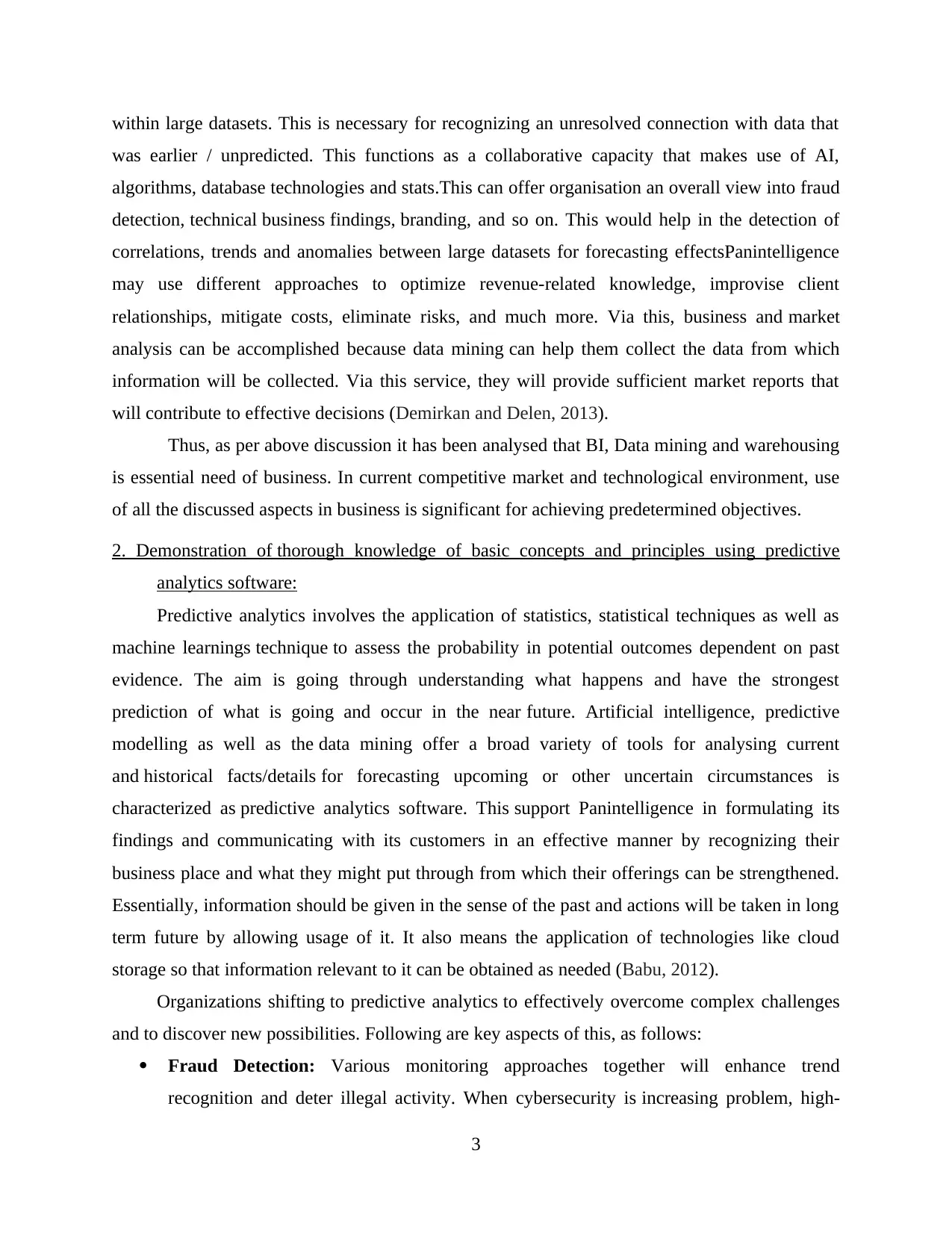
within large datasets. This is necessary for recognizing an unresolved connection with data that
was earlier / unpredicted. This functions as a collaborative capacity that makes use of AI,
algorithms, database technologies and stats.This can offer organisation an overall view into fraud
detection, technical business findings, branding, and so on. This would help in the detection of
correlations, trends and anomalies between large datasets for forecasting effectsPanintelligence
may use different approaches to optimize revenue-related knowledge, improvise client
relationships, mitigate costs, eliminate risks, and much more. Via this, business and market
analysis can be accomplished because data mining can help them collect the data from which
information will be collected. Via this service, they will provide sufficient market reports that
will contribute to effective decisions (Demirkan and Delen, 2013).
Thus, as per above discussion it has been analysed that BI, Data mining and warehousing
is essential need of business. In current competitive market and technological environment, use
of all the discussed aspects in business is significant for achieving predetermined objectives.
2. Demonstration of thorough knowledge of basic concepts and principles using predictive
analytics software:
Predictive analytics involves the application of statistics, statistical techniques as well as
machine learnings technique to assess the probability in potential outcomes dependent on past
evidence. The aim is going through understanding what happens and have the strongest
prediction of what is going and occur in the near future. Artificial intelligence, predictive
modelling as well as the data mining offer a broad variety of tools for analysing current
and historical facts/details for forecasting upcoming or other uncertain circumstances is
characterized as predictive analytics software. This support Panintelligence in formulating its
findings and communicating with its customers in an effective manner by recognizing their
business place and what they might put through from which their offerings can be strengthened.
Essentially, information should be given in the sense of the past and actions will be taken in long
term future by allowing usage of it. It also means the application of technologies like cloud
storage so that information relevant to it can be obtained as needed (Babu, 2012).
Organizations shifting to predictive analytics to effectively overcome complex challenges
and to discover new possibilities. Following are key aspects of this, as follows:
Fraud Detection: Various monitoring approaches together will enhance trend
recognition and deter illegal activity. When cybersecurity is increasing problem, high-
3
was earlier / unpredicted. This functions as a collaborative capacity that makes use of AI,
algorithms, database technologies and stats.This can offer organisation an overall view into fraud
detection, technical business findings, branding, and so on. This would help in the detection of
correlations, trends and anomalies between large datasets for forecasting effectsPanintelligence
may use different approaches to optimize revenue-related knowledge, improvise client
relationships, mitigate costs, eliminate risks, and much more. Via this, business and market
analysis can be accomplished because data mining can help them collect the data from which
information will be collected. Via this service, they will provide sufficient market reports that
will contribute to effective decisions (Demirkan and Delen, 2013).
Thus, as per above discussion it has been analysed that BI, Data mining and warehousing
is essential need of business. In current competitive market and technological environment, use
of all the discussed aspects in business is significant for achieving predetermined objectives.
2. Demonstration of thorough knowledge of basic concepts and principles using predictive
analytics software:
Predictive analytics involves the application of statistics, statistical techniques as well as
machine learnings technique to assess the probability in potential outcomes dependent on past
evidence. The aim is going through understanding what happens and have the strongest
prediction of what is going and occur in the near future. Artificial intelligence, predictive
modelling as well as the data mining offer a broad variety of tools for analysing current
and historical facts/details for forecasting upcoming or other uncertain circumstances is
characterized as predictive analytics software. This support Panintelligence in formulating its
findings and communicating with its customers in an effective manner by recognizing their
business place and what they might put through from which their offerings can be strengthened.
Essentially, information should be given in the sense of the past and actions will be taken in long
term future by allowing usage of it. It also means the application of technologies like cloud
storage so that information relevant to it can be obtained as needed (Babu, 2012).
Organizations shifting to predictive analytics to effectively overcome complex challenges
and to discover new possibilities. Following are key aspects of this, as follows:
Fraud Detection: Various monitoring approaches together will enhance trend
recognition and deter illegal activity. When cybersecurity is increasing problem, high-
3
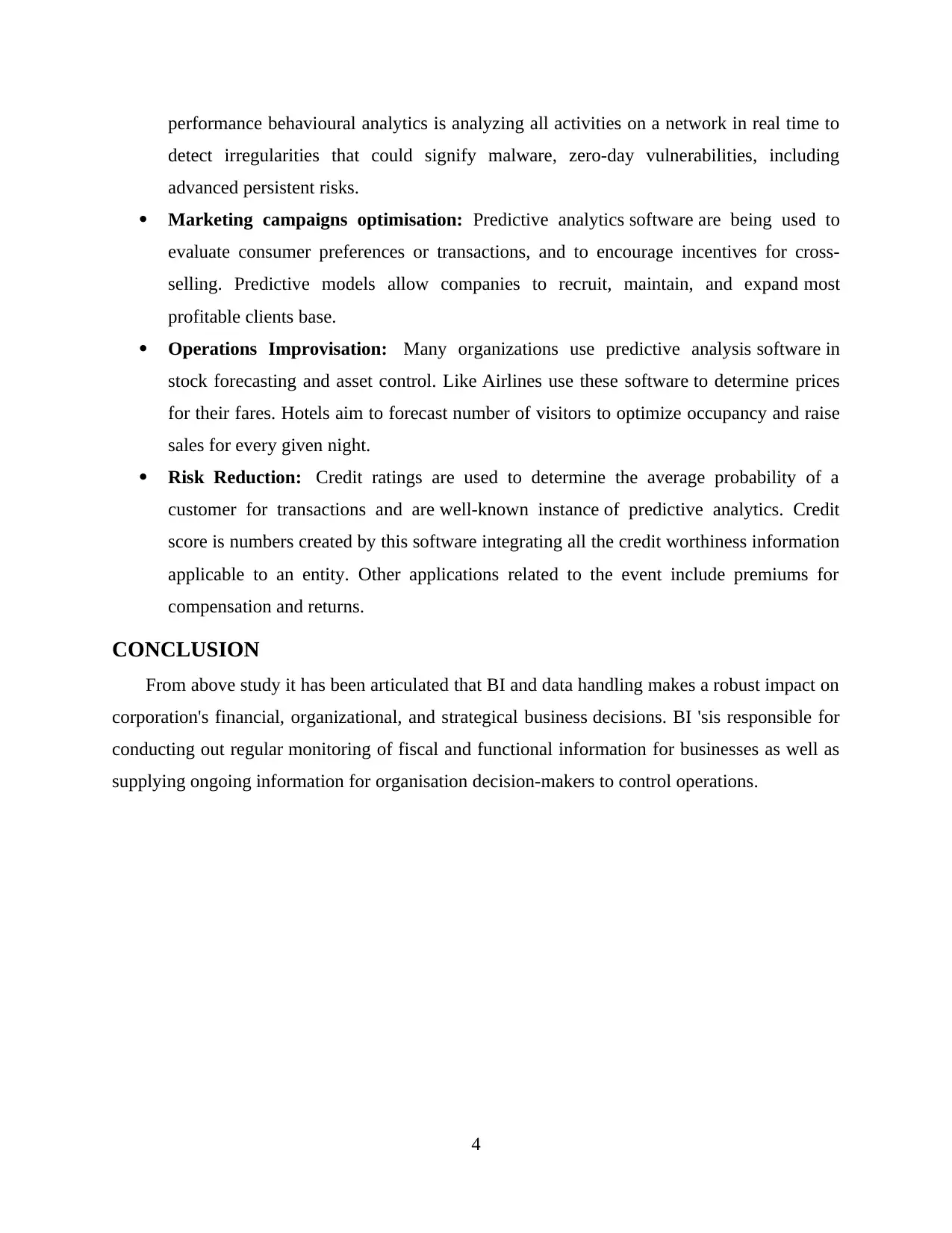
performance behavioural analytics is analyzing all activities on a network in real time to
detect irregularities that could signify malware, zero-day vulnerabilities, including
advanced persistent risks.
Marketing campaigns optimisation: Predictive analytics software are being used to
evaluate consumer preferences or transactions, and to encourage incentives for cross-
selling. Predictive models allow companies to recruit, maintain, and expand most
profitable clients base.
Operations Improvisation: Many organizations use predictive analysis software in
stock forecasting and asset control. Like Airlines use these software to determine prices
for their fares. Hotels aim to forecast number of visitors to optimize occupancy and raise
sales for every given night.
Risk Reduction: Credit ratings are used to determine the average probability of a
customer for transactions and are well-known instance of predictive analytics. Credit
score is numbers created by this software integrating all the credit worthiness information
applicable to an entity. Other applications related to the event include premiums for
compensation and returns.
CONCLUSION
From above study it has been articulated that BI and data handling makes a robust impact on
corporation's financial, organizational, and strategical business decisions. BI 'sis responsible for
conducting out regular monitoring of fiscal and functional information for businesses as well as
supplying ongoing information for organisation decision-makers to control operations.
4
detect irregularities that could signify malware, zero-day vulnerabilities, including
advanced persistent risks.
Marketing campaigns optimisation: Predictive analytics software are being used to
evaluate consumer preferences or transactions, and to encourage incentives for cross-
selling. Predictive models allow companies to recruit, maintain, and expand most
profitable clients base.
Operations Improvisation: Many organizations use predictive analysis software in
stock forecasting and asset control. Like Airlines use these software to determine prices
for their fares. Hotels aim to forecast number of visitors to optimize occupancy and raise
sales for every given night.
Risk Reduction: Credit ratings are used to determine the average probability of a
customer for transactions and are well-known instance of predictive analytics. Credit
score is numbers created by this software integrating all the credit worthiness information
applicable to an entity. Other applications related to the event include premiums for
compensation and returns.
CONCLUSION
From above study it has been articulated that BI and data handling makes a robust impact on
corporation's financial, organizational, and strategical business decisions. BI 'sis responsible for
conducting out regular monitoring of fiscal and functional information for businesses as well as
supplying ongoing information for organisation decision-makers to control operations.
4
⊘ This is a preview!⊘
Do you want full access?
Subscribe today to unlock all pages.

Trusted by 1+ million students worldwide
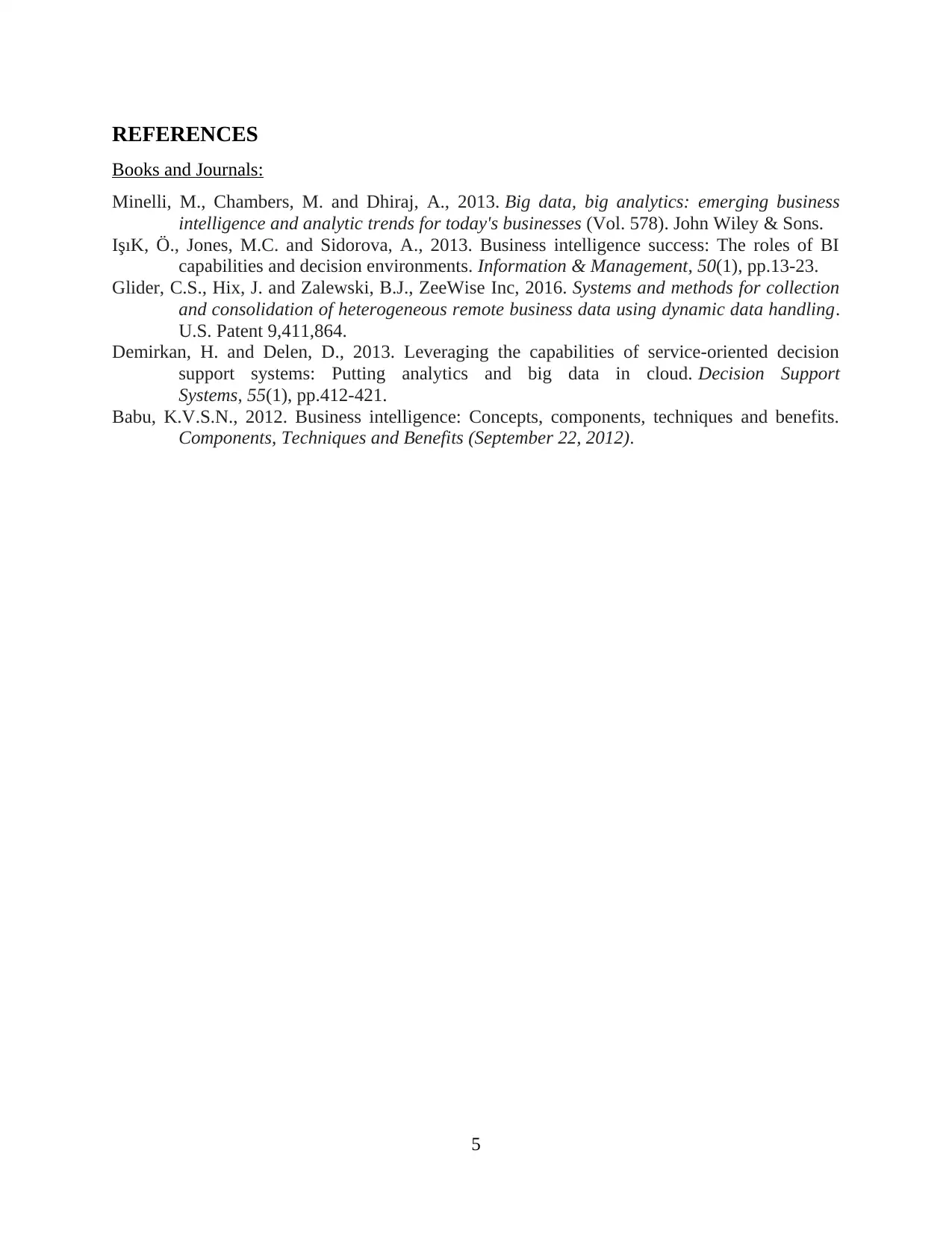
REFERENCES
Books and Journals:
Minelli, M., Chambers, M. and Dhiraj, A., 2013. Big data, big analytics: emerging business
intelligence and analytic trends for today's businesses (Vol. 578). John Wiley & Sons.
IşıK, Ö., Jones, M.C. and Sidorova, A., 2013. Business intelligence success: The roles of BI
capabilities and decision environments. Information & Management, 50(1), pp.13-23.
Glider, C.S., Hix, J. and Zalewski, B.J., ZeeWise Inc, 2016. Systems and methods for collection
and consolidation of heterogeneous remote business data using dynamic data handling.
U.S. Patent 9,411,864.
Demirkan, H. and Delen, D., 2013. Leveraging the capabilities of service-oriented decision
support systems: Putting analytics and big data in cloud. Decision Support
Systems, 55(1), pp.412-421.
Babu, K.V.S.N., 2012. Business intelligence: Concepts, components, techniques and benefits.
Components, Techniques and Benefits (September 22, 2012).
5
Books and Journals:
Minelli, M., Chambers, M. and Dhiraj, A., 2013. Big data, big analytics: emerging business
intelligence and analytic trends for today's businesses (Vol. 578). John Wiley & Sons.
IşıK, Ö., Jones, M.C. and Sidorova, A., 2013. Business intelligence success: The roles of BI
capabilities and decision environments. Information & Management, 50(1), pp.13-23.
Glider, C.S., Hix, J. and Zalewski, B.J., ZeeWise Inc, 2016. Systems and methods for collection
and consolidation of heterogeneous remote business data using dynamic data handling.
U.S. Patent 9,411,864.
Demirkan, H. and Delen, D., 2013. Leveraging the capabilities of service-oriented decision
support systems: Putting analytics and big data in cloud. Decision Support
Systems, 55(1), pp.412-421.
Babu, K.V.S.N., 2012. Business intelligence: Concepts, components, techniques and benefits.
Components, Techniques and Benefits (September 22, 2012).
5
1 out of 7
Related Documents
Your All-in-One AI-Powered Toolkit for Academic Success.
+13062052269
info@desklib.com
Available 24*7 on WhatsApp / Email
![[object Object]](/_next/static/media/star-bottom.7253800d.svg)
Unlock your academic potential
Copyright © 2020–2025 A2Z Services. All Rights Reserved. Developed and managed by ZUCOL.





